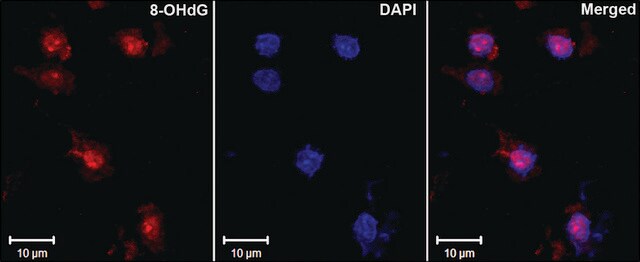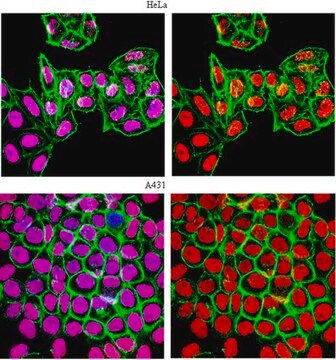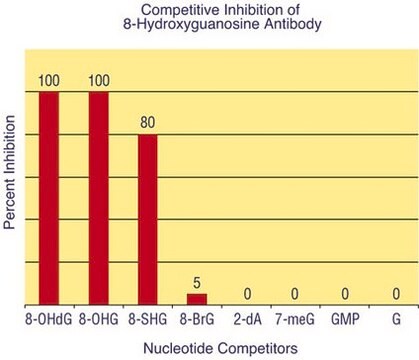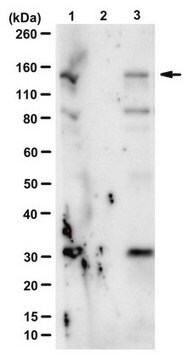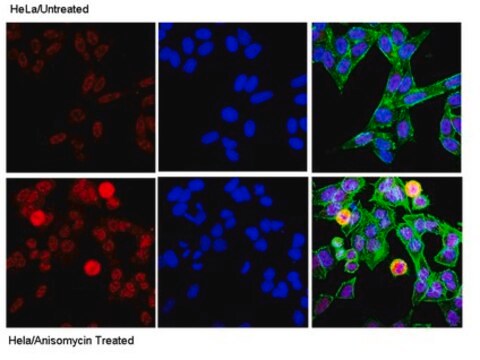05-740-AF488
Anti-phospho-ATM (Ser1981) Antibody, clone 10H11.E12, Alexa Fluor™ 488
clone 10H11.E12, from mouse, ALEXA FLUOR™ 488
同義詞:
Serine-protein kinase ATM, Ser1981-phosphorylated, Ataxia telangiectasia mutated, Ser1981-phosphorylated, A-T mutated, Ser1981-phosphorylated, ATM, Ser1981-phosphorylated
登入查看組織和合約定價
全部照片(2)
About This Item
分類程式碼代碼:
12352203
eCl@ss:
32160702
NACRES:
NA.43
推薦產品
一般說明
Serine-protein kinase ATM (EC 2.7.11.1; UniProt Q13315; also known as A-T mutated, Ataxia telangiectasia mutated) is encoded by the ATM (also known as AT) gene (Gene ID 472) in human. Ataxia telangiectasia mutated kinase (ATM) and ataxia telangiectasia and Rad3-related kinase (ATR) are related kinases that regulate cell cycle checkpoints and DNA repair. Mutation in the ATM gene results in the autosomal recessive disease ataxia telangiectasia (AT). Known ATM substrates include p53, p95/NBS1, MDM2, Chk2, BRCA1, CtIP, 4E-BP1, and Chk1. The S/TQ sequence constitutes the essential substrates phosphorylation site motif. Hydrophobic amino acids at positions -3 and -1, and negatively charged amino acids at position +1 are positive determinants for substrate phosphorylation, while positively charged residues surrounding the S/TQ are negative determinants. The complex phenotypes of cells derived from patients with AT suggests that ATM has additional cellular substrates. ATM is present as an inactive homodimer or multimer prior to activation. DNA double-stranded breaks induced by ionizing radiation (IR) cause rapid ATM autophosphorylation at Ser1981 in human or the Ser1987 equivalent in mouse.
特異性
Reacts with ATM phosphorylated at serine 1981. Clone 10H11.E12 is covered by US patent No. 6,916,627 and 7,108,992.
免疫原
Epitope: pSer1981.
KLH-conjugated, synthetic peptide corresponding to amino acids 1974-1988 (SLAFEEG[pS]QSTTISS) of human ATM. The immunizing sequence is 11/12 identical to the corresponding mouse and rat sequence.
應用
Anti-phospho-ATM (Ser1981) Antibody, clone 10H11.E12, Alexa Fluor™ 488 is an antibody against phospho-ATM (Ser1981) for use in Immunocytochemistry.
Research Category
Epigenetics & Nuclear Function
Epigenetics & Nuclear Function
Research Sub Category
Cell Cycle, DNA Replication & Repair
Cell Cycle, DNA Replication & Repair
The unconjugated antibody (Cat. Nos. 05-740, MAB3806 & MAB3806-C) is shown to be suitable also for ELISA, Immunocytochemistry, Immunofluorescence, Immunoprecipitation, and Western blotting applications. PE-conjugate (Cat. No. FCMAB110P) is also available and tested for Flow cytometry application.
品質
Evaluated by Immunocytochemistry in HeLa cells.
Immunocytochemistry Analysis: A 1:100 dilution of this antibody detected UV-induced ATM Ser1981 phosphorylation in HeLa cells.
Immunocytochemistry Analysis: A 1:100 dilution of this antibody detected UV-induced ATM Ser1981 phosphorylation in HeLa cells.
標靶描述
The unconjugated antibody (Cat. No. 05-430) is shown to recognize the ~370 kDa phosphoATM target band and a >400 kDa non-specific band.
外觀
Protein G Purified
Purified mouse monoclonal IgG1κ antibody conjugate in PBS with 15 mg/mL BSA and 0.1 % sodium azide.
儲存和穩定性
Stable for 1 year at 2-8°C from date of receipt.
其他說明
Concentration: Please refer to lot specific datasheet.
法律資訊
ALEXA FLUOR is a trademark of Life Technologies
免責聲明
Unless otherwise stated in our catalog or other company documentation accompanying the product(s), our products are intended for research use only and are not to be used for any other purpose, which includes but is not limited to, unauthorized commercial uses, in vitro diagnostic uses, ex vivo or in vivo therapeutic uses or any type of consumption or application to humans or animals.
未找到適合的產品?
試用我們的產品選擇工具.
儲存類別代碼
12 - Non Combustible Liquids
水污染物質分類(WGK)
WGK 2
閃點(°F)
Not applicable
閃點(°C)
Not applicable
分析證明 (COA)
輸入產品批次/批號來搜索 分析證明 (COA)。在產品’s標籤上找到批次和批號,寫有 ‘Lot’或‘Batch’.。
我們的科學家團隊在所有研究領域都有豐富的經驗,包括生命科學、材料科學、化學合成、色譜、分析等.
聯絡技術服務